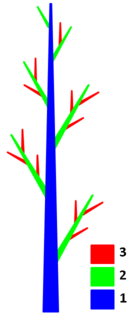Preliminary Course
Botany. Architectural Analysis
Plant structure organization
Branched systems
-
The branching process builds branches in leaf axils.
The branching process allows a plant to explore many directions, from one axis through new lateral axes building a branched system.
The description of a branched system implies the use of a precise topological terminology.
Branching develops a natural hierarchy in the plant structure.
On a given axis position, this hierarchy is classically defined from its order, a numeral ranking for the number of branching processes involved up to reaching the axis position, starting from the seed.
In plant architecture analysis, it is usual to use ordinal numbers and to consider the main stem arising from the seed as the order 1 axis, whereas the axes it gives rise to are referred to as order 2 axes and so on.

Branching orders, identified by their rank number and colour (drawing M. Jaeger, CIRAD)
The branching order 1 axis, is the main stem, arising from the seed.
Branching order 2 axes, in green, stand for branches borne by the order 1 axis
Branching order 3 axes, in red, stand for branches borne by the order 2 axes
In a sympodial system, a rigorous use of this terminology will lead to the reference of the successive sympodial units as axis orders 1, 2, 3, etc. In the architectural botany approach, each rectilinear succession of modules, even though not strictly emitted by a single meristem, will be considered as an axis and will represent an "apparent branching order".
